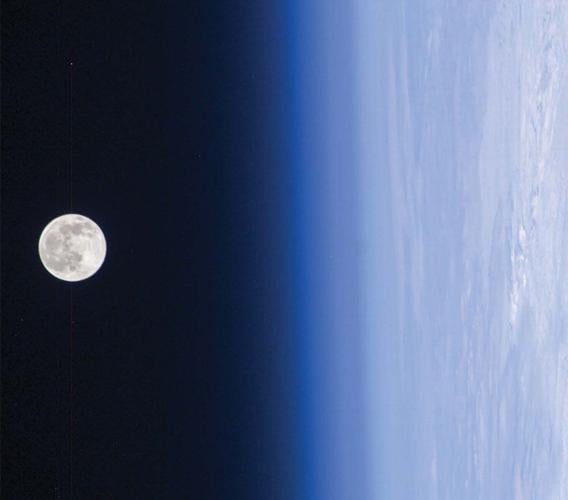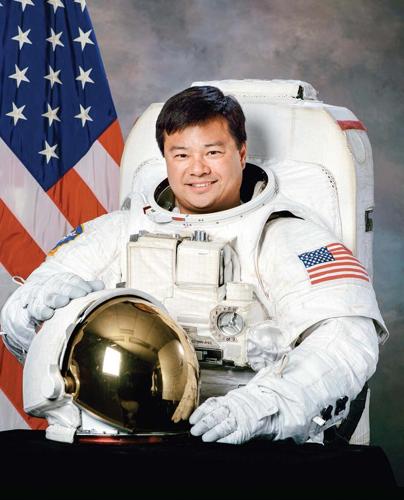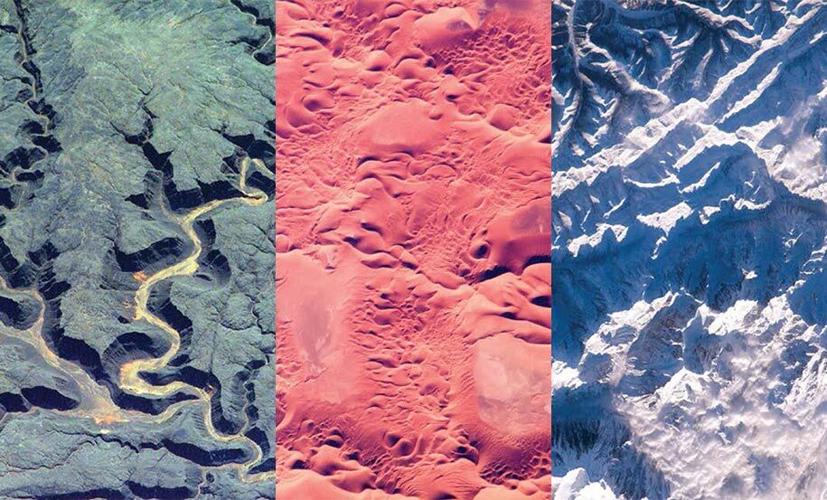
When Leroy Chiao was just a toddler growing up in MKE, he recalls the first twinges of a life of exploration.
His family’s Milwaukee suburb backyard seemed huge at the time. “It was enormous,” says Chiao. He’d tag along as his mother puttered in the backyard, fascinated by vibrantly colored beetles scurrying along. That sense of curiosity and discovery never went away when his family moved from Milwaukee when he was 3.
“I certainly remember Milwaukee with a lot of fondness,” says Chiao, who was born in 1960. Chiao’s parents — both chemical engineers attending graduate school — immigrated to the U.S. from China in the late 1950s.
“My father always said my mom was the one that had the vision to leave Taiwan to find a future in America,” Chiao says. “She pushed my dad to try to get into a U.S. graduate school. It was a huge and life-changing to have those opportunities that were afforded here.”
The Chiao family maintained the Chinese culture at home while also embracing American traditions. “They wanted us to assimilate into the U.S. mainstream as quickly as possible, but wanted to retain some Chinese cultural parts at home,” he says.
“We grew up bilingual, learning English at school and Chinese at home,” he says. “The work ethic is part of the culture — so is the goal of helping others and being selfless. I really had the best of both worlds growing up in two cultures.”
Milwaukee left an impression on Chiao. “I grew up with friendly neighbors and values,” he says. “They'd bring us things and we talked to them outside.”
In 1996, he got the chance to return to MKE. He flew here with his NASA colleagues and drove to Oshkosh for the airshow at the EAA.
“It was neat to be back in Milwaukee after all those years,” he says. “Didn't really have a chance to go look around, but I would love to go back and explore the city some more.”

A Life of Roaming
After he moved from Milwaukee, Chiao lived in Wichita, Kansas, and California. When he was almost 9, his family gathered around their black-and-white TV on July 20, 1969, to watch the Apollo 11 moon landing.
“It was just incredible to look up at the moon and realize almost a quarter of a million miles away, these two astronauts were getting ready to take those first steps,” Chiao says. “I remember thinking, ‘I want to be like those guys. I want to be an astronaut.’”
The first step toward that goal was studying engineering, influenced by his parents’ background. “I liked figuring things out, putting things together,” Chiao says. “I was always building things in the garage — model airplanes, model rockets, using scraps of wood and making boats or cars.”
“I thought flying on a rocket would be just the ultimate adventure — flying into space and getting to look back at the earth would just be incredible,” he says. “Because of the timing, I didn't get the chance to go to the moon, but I got to do a lot of really cool stuff in low Earth orbit.”
Chiao, who had a doctorate in engineering, was selected by NASA in January 1990, and became an astronaut in July 1991. His technical background in engineering, which helped him understand the systems of the spacecraft, rocket and experiments, was a huge assist, he says.
“From a young age, I was programmed to study engineering, which was what I wanted,” he says. “I liked figuring things out, putting things together. We always had tools in a workbench, and I was always building things in the garage — model airplanes, model rockets, or just using scraps of wood and making boats or cars.”
At age 29 and with a an engineering doctorate degree in hand, Chiao was selected by NASA in January 1990. He became an astronaut in July 1991.
“I always knew that the numbers were against me,” he says. “There were a lot of people applying for very few slots. I knew I was just going to keep trying, and if it didn't work out, that was okay — I had a rewarding career,” says Chiao. “Fortunately for me it did work out, and the transition was very easy.”
It was a big career shift, he says. “I knew I wouldn't be doing engineering work anymore. The technical background was necessary to be able to understand the systems of the spacecraft, the rocket, how everything worked, and understand the experiments I would perform in space. Education was an important part of being able to do those requirements.”

Liftoff to Space
Chiao’s 15-year career with NASA began as an astronaut and eventually rose to International Space Station (ISS) commander.
As an astronaut, he worked on a variety of flights. His first science mission — two weeks in orbit — involved work on the payload bay of the space shuttle Space Lab, the predecessor to the ISS and the primary method to do research work in space.
“It was mini-space station that would only fly two weeks at a time,” says Chiao. “We performed over 80 different investigations during those two weeks. The scientists on the ground were really happy with the results.”
His next mission gave him the opportunity to go on his first two spacewalks and help his team test tools and construction techniques that NASA would later use to build the ISS.
“It was a great experience to test tools, power connectors and fluid connectors used to put together that big space station,” he says. “We learned a lot from our series of flight tests —space walking, tools, and construction techniques.”
On his third mission, he worked on the second major assembly of the ISS. That included his team bringing two big pieces of the station with them in the payload bay of the space shuttle. The team used a robotic arm to position the pieces in the right places, bolted them down, connected the cables and “brought them all to life,” he says.
Chiao was also once again leader of the spacewalking team. They split into two teams and went out on four spacewalks. In a memorable spacewalk, his boots were attached to the robotic arm and he was remotely moved from one work site to another.
“Space walks are kind of surreal,” he explains. “It's almost like being in a dream. Over the course of almost a minute during that transition, I was face down to the earth and I couldn't see either the shuttle or the space station in my peripheral vision. I was watching the clouds and continents roll by. I felt like a satellite flying over the earth — a really cool feeling.”
In his fourth flight, he trained with Russian cosmonauts. He spent a lot of time in Star City outside of Moscow (“the equivalent of the Johnson Space Center in Houston). Ultimately, Chiao flew to the ISS via a Russian spacecraft and served as the commander and NASA science officer during Expedition 10, a six-and-a-half-month flight.
As mission leader, Chiao engaged in two Russian spacewalks wearing a Russian-made spacesuit and installed navigation antennas, deployed a few experiments and retrieved experiments to bring down to earth. It was an eventful way to cap his time in space, he says.
Overall, Chiao has 229 days of spaceflight experience. “I had an opportunity to do everything there was to do in my astronaut career,” he says.
Even years after his last space mission, the skills he learned continue to be useful for everyday life. “It’s important to develop your ability to work in a team, be flexible, stand up and be the leader when you're supposed to be, and then follow when that's appropriate,” says Chiao. “All those are important skills, and not just for an astronaut, but also in other venues of life too.”
Now based in Houston, Chiao consults with various space companies and connects with educators, businesses and students on workshops, corporate keynotes, and specialized school programs through OneOrbit to inspire the next generation. MKE

Myth Vs. Fact: Working In Space
Working in a space suit is nothing at all like the movies or fiction books where you just put your suit on and in a matter of a couple minutes hop in the airlock and get outside.
• “It takes several hours to go through the preparations and get all the equipment together and get your suit on, go through all the checks,” says Chiao. “Once you’re suited, in the airlock and the hatches are closed, it takes quite a bit of time to bring the pressure down inside the airlock. You're stopping to do leak checks and equipment checks.”
• The airlock is REALLY small. “You want the volume of gas that you have to either release into space or pump back into the station to be small so that you don't lose all that atmosphere,” says Chiao. “You're pretty cramped in there.”
• It’s not quiet. “You can't hear — it's very loud,” Chiao says. “You've got a fan blowing oxygen over your face; you can't hear yourself breathe or your heartbeat or anything like that.”
• The suit is very stiff and is inflated to keep you alive. The pressure inside protects astronauts from the vacuum of space. “You're working inside a balloon. Just moving your fingers or arms takes a lot of effort,” Chiao says. “Over the course of a six-and-a-half-hour spacewalk, it's physically demanding. It’s important to keep yourself in good physical shape, especially if you're going to be doing spacewalks. You’ve got to be strong and have enough endurance.” Chiao prepped by spending time in the gym prior to the mission.
• When you return from a spacewalk, there’s a lengthy process of repressurize the airlock, going through all the checks, getting the suit off, cleaning everything and putting it away. “It's completely different than the movies,” Chiao says.
• The only thing movies get correct is the “stunning view,” Chiao says. The film “Gravity” captured the look and feel of being outside on a spacewalk, he says, “but everything else about it was fake.”

Left to Right: Africa, Algeria, Burma
Favorite Hobbies in Space
While Chiao says his days in space were “scheduled down to the minute,” he had free time and “evenings” after the workday to relax. A few pastimes he engaged in miles above the earth:
• Taking pictures of the earth. He shot more than 16,000 photos, and “every part of it looks different and is beautiful in its own way. The colors are very bright, very vivid, and you can always find something interesting to see.”
• Keeping in touch with family through email and sending them photos. When the antenna dish is pointed at the satellite, he was able to use an internet protocol phone to make short phone calls down to people on the ground. “It was always fun to surprise people with a call from the space station,” he says.
• Watching DVDs from the station’s quality library.
• Listening to e-books and reading.





